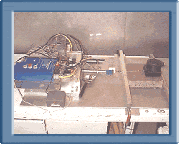Institute of Snow Research
| Services | Introduction | About ISR | ||
| Keweenaw Snow Paver | Anti-Icing and Deicing Research | Elastomeric Coatings | T.R.A.C.S. | Vehicle Mobility Testing |
Controlled Performance Testing of Deicing and Anti-Icing Chemicals
| Introduction | ||||||||||||||||||||||||||||||
|---|---|---|---|---|---|---|---|---|---|---|---|---|---|---|---|---|---|---|---|---|---|---|---|---|---|---|---|---|---|---|
|
In recent years, there has been a major effort underway to develop new chemicals for use as deicers and anti-icers. This effort has been driven in part as a means to reduce environmental effects of winter maintenance operations as well as to enhance the ability of applied chemicals to act as anti-icers. The search for new methods to maintain pavements at an "acceptable" safety level can be broken into two major categories:
Mandates to reduce the use of some common freezing point depressants and the development of new chemicals with claims that these are bigger and better than the old way has put managers in a position to wonder how to decide what to use. Questions that must be asked are "What do I replace chemical X with now that I am no longer allowed to use it anymore?" and "Is there something better?". To answer these, a third question must be answered, "How do I figure out what is best?". |
||||||||||||||||||||||||||||||
| Background | ||||||||||||||||||||||||||||||
|
Testing at the Keweenaw Research Center has been carried out for several different reasons. The most common of these are companies wondering if their new chemical works, companies in need of performance documentation for a client or advertisement, buyers looking to decide between several prospective chemicals, and pure research of chemical additives and application scenarios. Companies that are in the deicer market are always in need of comparison testing as well as new product testing. There has been a lot of interest in corrosion inhibitors and their effect on performance in the past couple of years. Performance testing has also been contracted for use in advertisement literature. User perspective testing has generally been performed by government agencies looking to better serve the vehicle operating public and to try to decrease the cost of winter maintenance without degrading the level of service. In some cases, companies are required to get a "seal of approval" by an outside testing institution before their chemical can be put on the list of potential deicers for a given market. All of this said, there is a need for performance testing in several areas. This testing can generally be performed quite rapidly in the laboratory and then is usually brought into a larger field testing scenario of some sort. |
||||||||||||||||||||||||||||||
| Testing and Data | ||||||||||||||||||||||||||||||
|
Test data open in a new window.
|
||||||||||||||||||||||||||||||







